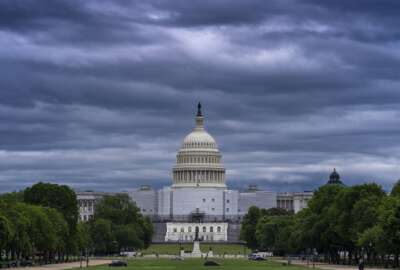Congress is gone until next week, but the budget questions drone on
Budget talks in Congress are in suspended animation this week because of the 4th of July recess. When members return, they will have only three weeks until the...
Budget talks in Congress are in suspended animation this week because of the 4th of July recess. When members return, they will have only three weeks until the August recess. For a recap of the sticking points, Federal Drive with Tom Temin spoke with WTOP Capitol Hill Correspondent Mitchell Miller.
Interview Transcript:
Tom Temin And so give us the latest on what’s going on here.
Mitchell Miller Well, the animation will begin very soon and Congress is only going to have three weeks to make significant progress in the appropriations process before they head out again for the August recess, of course. And there’s really more urgency this time around than there often is during the summer months because of the debt ceiling legislation that’s trying for regular order. The Senate Appropriations Committee led for the first time by two women, Washington Democrat Patty Murray and Maine Republican Susan Collins recently conducted the first full committee markup by that panel in two years, believe it or not. And the next steps will include debating all of those 12 annual government spending bills and then moving on to negotiate them with the House. And remember, if Congress does not pass all of these bills by January 1st, then the debt limit bill kicks in and there’s a 1% across the board spending cut until Congress approves all these funding measures.
Tom Temin This timing then becomes crucial because after August, they’ve got the month they’re here the month of September. But there’s a holiday in September, more than one holiday day.
Mitchell Miller Right. So they’re really rushing to try to get some of this done. And the Senate Appropriations Committee did make some progress recently. Earlier this month, they approved military construction, VA funding, agriculture, FDA appropriations bills. But to show you where they have to get to the final point, where they’re actually going to get this all approved by the House and the Senate. Just to give you a few examples of how far apart the House and the Senate are. Here’s a few numbers. In the Commerce Justice science area, senators proposed nearly $70 billion for commerce, justice, NASA, and that’s a decrease from $84 billion in current funding. Meanwhile, House Republicans proposed just under $59 billion. Another area, Labor and Health and Human Services, Education, the Senate spending level is about $195 billion. House Republicans proposing about $50 billion less than that. So these are huge numbers that they’re going to have to somehow get together on. And right now, it looks like the House Republicans, as you might imagine, are going to keep pushing hard, trying to utilize leverage to try to get some of these numbers down. But that’s why we’ve talked about in the past where there could be this clash that eventually could lead to a government shutdown.
Tom Temin Yeah, $50 billion delta, 195 billion versus 145 for this Labor, HHS, Education complex. That is a wide gap. The question becomes, who’s going to give on each way to get somewhere toward the middle if it’s even possible?
Mitchell Miller Right. And of course, you have that hard right side of the Republican conference, the House Freedom Caucus, they are all talking about the fact that they are not going to budge on a lot of these numbers. Of course, House Speaker Kevin McCarthy will have to do a lot of negotiating and trying to balance the interests of his far right part of the conference, as well as with the moderates who just want to get some kind of agreement done. I think it’s interesting to I have learned over the last few weeks that no matter whether lawmakers are conservative, moderate Democrat or Republican, there seems to be a resignation that we may be headed for another continuing resolution, even after all this talk about getting to regular order and getting all these appropriations bills. A lot of people just don’t see how given that timeframe in September, as you mentioned, with that, also with another break built in there that they’re going to be able to meet this October 1st deadline and get it all done before the start of the new fiscal year.
Tom Temin Right. And if they want to avoid a government lapse in funding, then they could have the continuing resolution go for the whole year.
Mitchell Miller Right? Potentially they could. And then and then you move up to that January 1st deadline. And even though some people on the appropriations committees have said, well, effectively, once this 1% across the board cut goes into effect, it really won’t take place for a few months. Nonetheless, that’s a that’s a hard deadline in that legislation. And that’s really something that they’re going to have to reconcile as they get through these next few months.
Tom Temin We’re speaking with Mitchell Miller. He’s WTOP’s Capitol Hill correspondent. And on the defense side, they’re a little closer, though, right?
Mitchell Miller They are. Actually, the House has proposed more money, whereas the cuts are really big in a lot of the other areas that we just mentioned. So they are very close with the House and Senate on Defense Appropriations Committee. I think what we will see also is more of a move to get more funding from the Senate side. You have people like Senate Minority Leader Mitch McConnell still pressing to provide assistance to Ukraine. He devoted several days in a row earlier this month in his floor speeches to talking about Ukraine, about the war effort, an effort to get allies to pay their share as well. So. I think that while, you know, we have a lot of differences in a variety of areas, I think that’s one area where eventually lawmakers are going to be able to get close together on that issue.
Tom Temin And getting back to the civilian side, some of the rhetoric is a little bit heated. I mean, there’s talk, again among some of the House super conservatives about defunding Justice and the FBI. Sounds like defunding the police in some sense, and that’s not what you would expect them to say.
Mitchell Miller Right. This is really interesting. It’s kind of a flip of everything that happened before. Right before Democrats were criticized by Republicans for talking about defunding the police. Now, Democrats are criticizing Republicans for their talk of defunding the Justice Department and the FBI. Now, a lot of that obviously is heated rhetoric, but there are some real proposals there from the conservatives among the Republicans about cutting the Justice Department and even on the Senate side, holding up some of the nominations in connection with the president’s Justice Department nominees. And the FBI has come under a lot of heat, as you know, in connection with a whole variety of issues that a lot of Republicans have grievances with. I do think that this will primarily be a lot of the rhetoric that tends to float around Washington. I don’t see major cuts coming in the Justice Department or the FBI. I think on the Senate side, they’re going to get a lot of pushback from Republicans and Democrats, frankly. But nonetheless, this is going to be something that is going to continually get sand in the gears as they try to reach agreements on so many of these spending issues.
Tom Temin And, of course, there’s a couple of authorization issues, too, coming up. We’ve got the NDAA, which is moving apace, it seems to be. And then that big FAA authorization.
Mitchell Miller Right? The NDAA, that’s one of the bright spots, as you know, within the congressional appropriations process. It does look like it’s on track to, again, for more than six decades, get the approval that it needs. Senator Tim Kaine on the the Virginia senator on the Armed Services Committee has continually talked to me about his optimism that things are going to move ahead, apace on that. And then the FAA reauthorization mark up that is a little bit different. You know, we talked recently about the fact that it kind of did not come in on the glide path, forgive me on that, that they had hoped and that there is it’s kind of in a holding pattern right now because there’s some disagreements on a variety of spending issues. Among them, of course, those additional slots or flights at Reagan National Airport. Opposition there from Virginia and Maryland. And then also there has been talk during this holiday period because of all the storms and everything that often hold up people when they’re traveling during this holiday period, there’s still consideration of trying to get more people hired within the whole FAA framework, if you will, including not only just TSA, but a lot of some lawmakers point out that there aren’t enough air traffic controllers, that there’s not enough staffing at some of these airports as they try to get through a lot of these complicated issues during the summer storms. So a lot of things that need to happen there with the FAA. And of course, lawmakers have a big interest in that because members of Congress are among those who fly the most of anybody across the country.
Tom Temin Yes. So the FAA bill seems to be in the quagmire that is mirrored by the airport situation over the past number of weeks when everything is frozen solid. Golly. Just a final question. What’s it like on Capitol Hill these days in terms of visitor access and so on?
Mitchell Miller It’s really interesting The amount of visitor access since it was really essentially reopened earlier this year is something that I haven’t seen in several years. I mean, we have seen more visitors on Capitol Hill over the last several weeks than I have ever seen. And it’s really great to see. You see huge numbers of kids and classes coming from all across the country, all kinds of special interest groups. You see a lot more lobbyists, frankly, moving around the Hill and a lot of people heading to meetings and going on. And so it does seem after a pretty long period where things were not very normal here at the Capitol, that things are moving back into that pace that you normally see with a lot of visitors coming in, a lot of people stopping you and asking you questions like, where is the Capitol Visitor’s Center? Where’s the Washington Monument? Although the other day we could barely see the Washington Monument because of the air quality. But nonetheless, it’s really nice to see the U.S. Capitol complex coming back the way it has been.
Copyright © 2025 Federal News Network. All rights reserved. This website is not intended for users located within the European Economic Area.
Tom Temin is host of the Federal Drive and has been providing insight on federal technology and management issues for more than 30 years.
Follow @tteminWFED






